Mnemonics (ne-maw-nix) are methodical ways to assist and improve memory. They are mental tools that make information meaningful and easier to recall.
Some mnemonics are simple, like making an acronym for a concept. Example – How do you give good feedback? It should be Feed-forward, actionable, succinct, and timely. A mnemonic for this could be F.A.S.T. Some mnemonic ‘systems’ require homework, like the mind palace technique.
Ideally, you would use mnemonics to remember study material or quickly absorb the information you gain in a seminar or meeting when taking notes is impractical. But at the very least, knowing mnemonic techniques to remember anything you’d like is a great way to impress someone.
Like chess grandmasters, there are memory grandmasters who remember incredible amounts of information in one go. Lkhagvadulam ENKHTUYA[1], a woman from Mongolia, is a grandmaster who could remember 535 random cards in 10 minutes and 1024 digits in just 15 minutes! Experts in memory claim that you don’t have to be a miracle child to achieve this gargantuan feat; you just need a little practice and strategy.
The secret to remembering a lot of information is using a framework and learning that framework.
1. Chunking
Chunking, one of the most profound insights into how the brain works, is both a general memory technique and a study technique. Chunking simply means large information is grouped into small components, typically meaningfully. Our working memory holds information that needs immediate attention, but it is limited to 4-9 items. But when chunked, the actual amount of information is a lot higher. For example, a person might fail to remember a phone number like +555 47925930 because there are 11 digits to it, so 11 individual components. But if you chunk it as +555 479 25 930, it’s a lot easier to remember because the brain treats it as 4 individual items.
| raw information | chunked information |
|---|---|
| 482045820 | 482-045-820 |
| Table, Apple, Keys, Soda, Bread, Cheetah, Cat, Chair, Laptop, Bottle | Study room (Chair, Table, Keys, Laptop, Bottle) Animals (Cheetah, Cat) Kitchen (Apple, Soda, Bread) |
| There are 11 subjects you study this year: algebra, geometry, history, geography, German, English, Psychology, Physics, Design, Electronics, Chemistry | math (algebra, geometry) social science (history, geography, psychology) Technology (design, electronics) language (German, English) Science (Physics, Chemistry) |
| I went with my friends Alegra, Sanjay, and Kevin on a road trip and ate so much – fried chicken, shrimp rice, pudding, and even stopped at a McDonald’s on our way. | Friends (Alegra, Sanjay, Kevin) Food (fried chicken, shrimp rice, pudding, and McDonald’s) |
Visual information can also be chunked similarly. Instead of counting and serially remembering the items in the image below, chunk them by grouping a few items together and remember the groups and the items contained within.
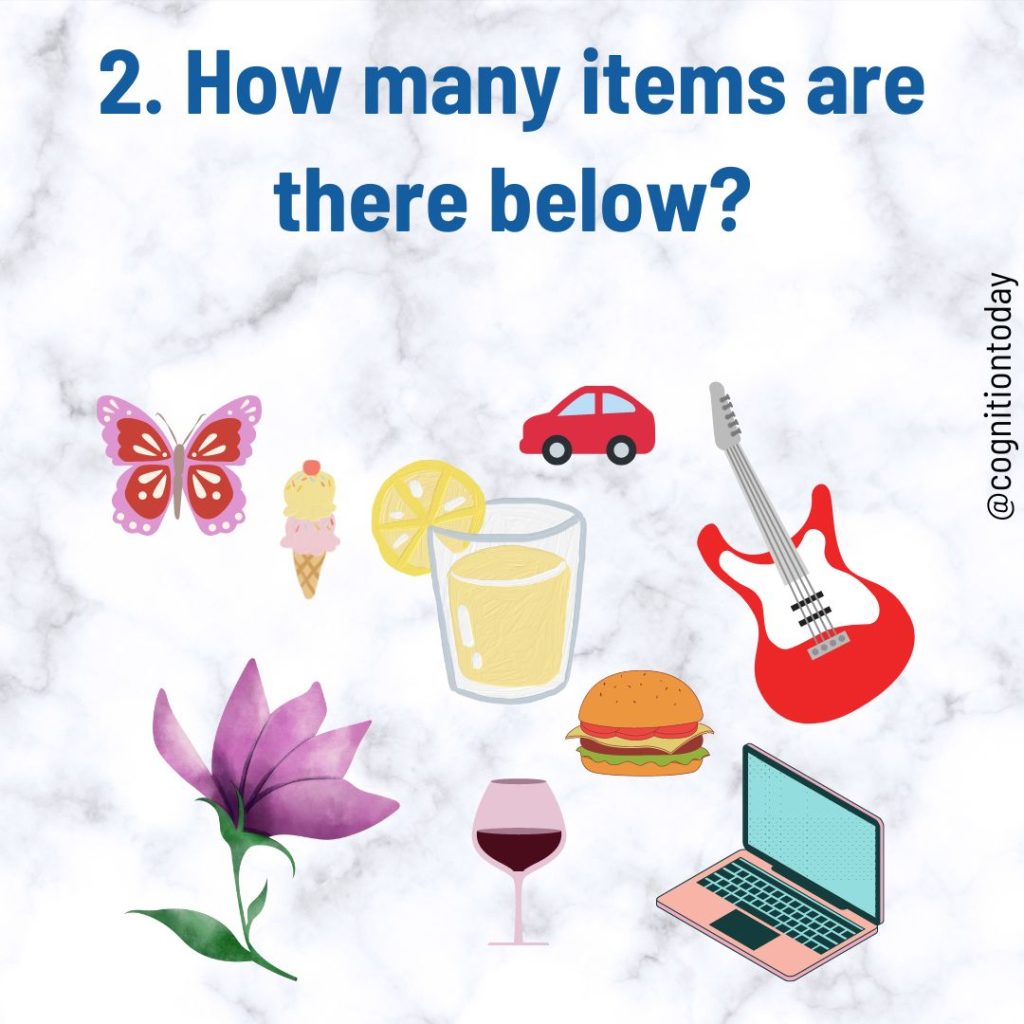
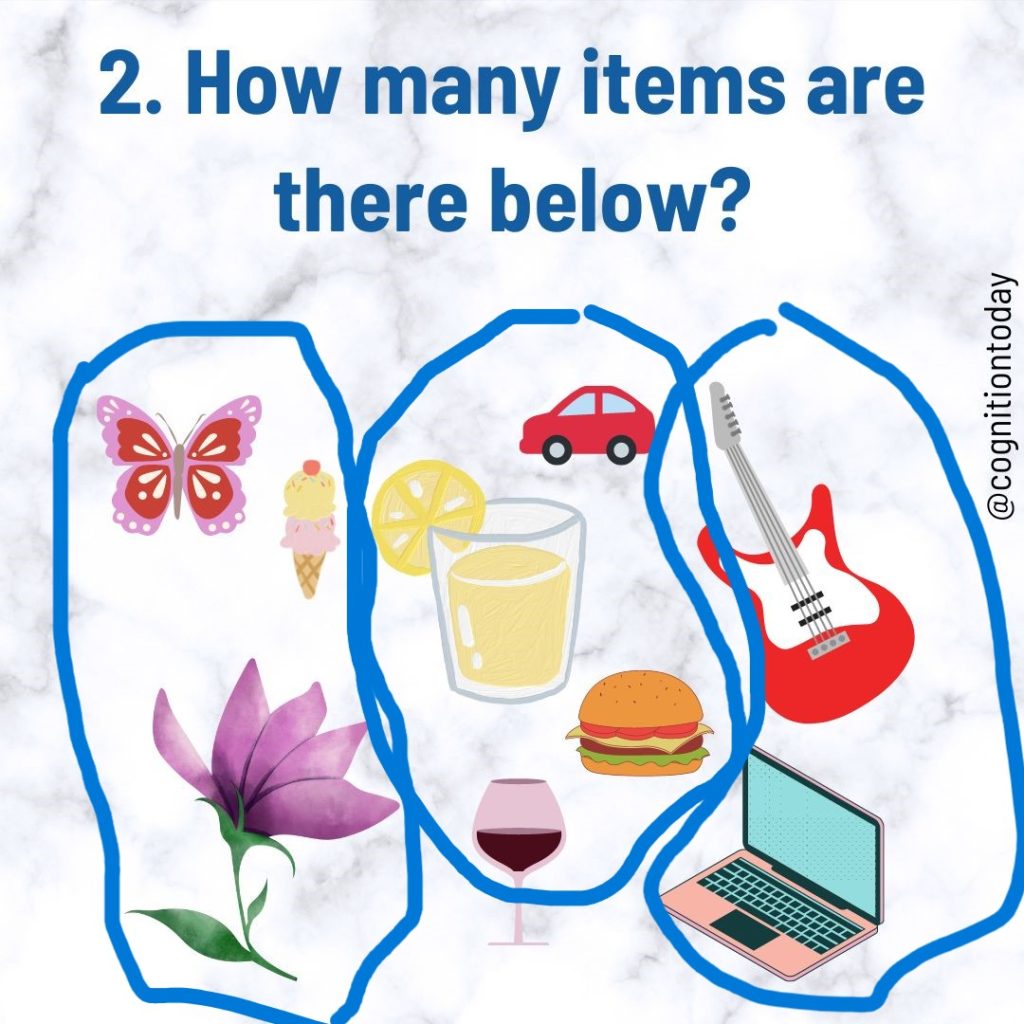
2. The Major System
The Major system can be used to remember numbers. Basically, you assign a fixed letter to each single-digit number and then use a combination of these letters based on the number you want to remember by making words. Words are easy and meaningful and, therefore, easy to remember.
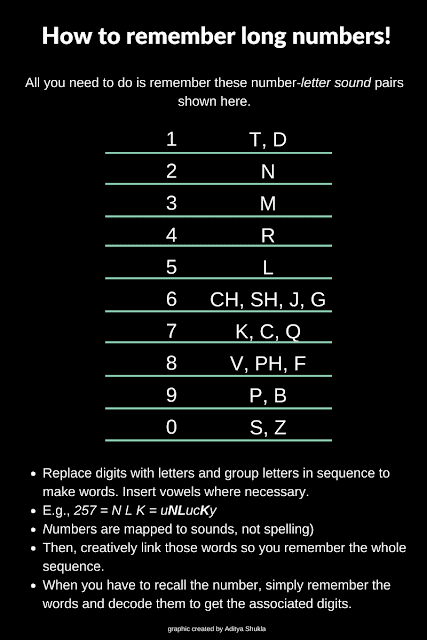
3. The mind palace (Sherlock’s technique)
The mind palace (what Sherlock Holmes uses) is a very powerful tool that leverages the visuospatial memory circuits. One of the most powerful memory systems for the brain is the memory for spatial location and its visual aspects. It’s also called the method of loci or the Roman house. It’s one of the best techniques to remember a huge list of items, new vocabulary, a deck of cards, or faces.
- Consider your house, school, or office as a blueprint. This is your palace. The blueprint of your palace includes 2 levels of details: The layout of rooms + objects in the room.
- At each significant spot in the house or the area, you ‘place’ information by creating an association of that place and the information. The easiest way is to identify all the objects, windows, and doors in the room and use them to associate information with.
Example: This is my bedroom. It’s a room in my memory palace, which is the whole house. I have to remember 6 animals: Zebra, lion, monkey, human, owl, caterpillar.
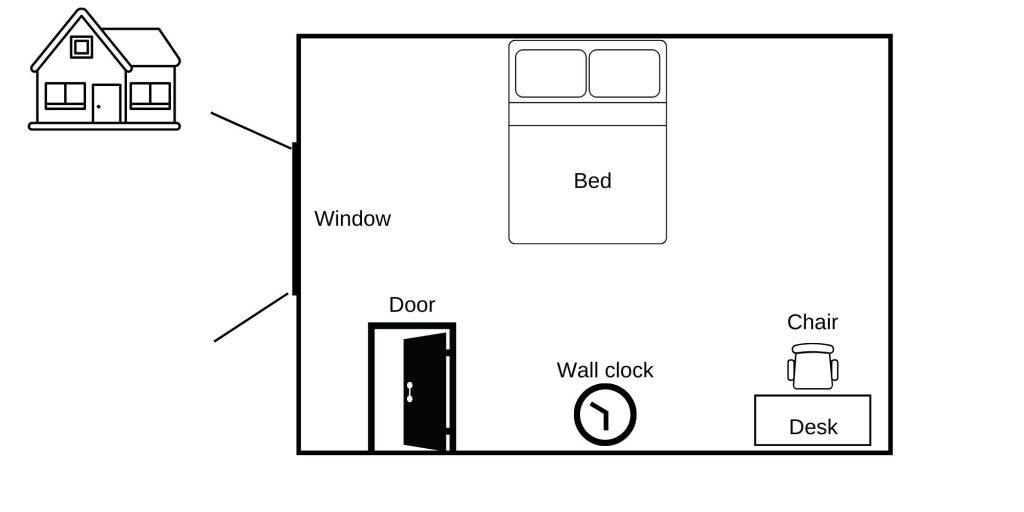
- I’ll visualize a zebra walking inside the door and being too tall for it.
- I hear a roar, so I rush to the window to spot the lion.
- I see a monkey sleeping on the bed
- A human is doing Excel sheet work.
- The desk has a small wooden owl figurine for good luck.
- The wall clock has a caterpillar near the number 11, making it look like 111.
Now, if I have to recall the animals in that specific order, I just walk through the room, identify each object, and recall the animal associated with that location.
To retrieve, follow rules so you don’t mess up the order of remembering items. The memory palace is very powerful in remembering random information in sequence or directly jumping to a specific position in the list.
Rules I recommend:
- Start at the main gate or entry point of a location.
- Place items in the palace clockwise by starting on your left.
- If a single area has more than 2 important locations in the palace, begin at the bottom and then go above.
- Do not repeat a location.
4. The number-visualization peg system
The peg system is fairly easy. You can learn it in 10 minutes. The user makes a fixed number-object association, which we call ‘pegs’. We then use the peg to create an association with new information. So, it is easy to recall target information by remembering the peg and the association. Once the peg is known, you can instantly tell the numerical position of that information. In short, you fix an object you can visualize with numbers 1 to 10. Once you do that, you have a handy tool to remember to-do tasks, glossary lists, this answer, etc. Get creative with the associations. I’ll give an example.
Each number from 1 to 10 gets a rhyming word, which is called a “peg”. The number and peg are married. Then, associate any information you want with the peg, and you’re done!
The pegs rhyme with the 1 to 10 number order, so they are naturally memorable, and you can pull out information from any number in the list without going through the whole list.
Here are the pegs
- One – sun
- Two- Shoe
- Three – Tree
- Four – Fort
- Five – Hive
- Six – Fix
- Seven – Heaven
- Eight – Ate
- Nine – Spine
- Ten – Hen
Now, all you do is remember your list of items by pairing the item with the peg and having a vivid visualization or a mini-story.
Here’s a list of great words to start wordle: Adieu, Stare, Alert, Point, Crane. The way to remember these in order is:
- Imagine bidding adieu to the sun (the peg for 1) while you zoom away in a spaceship.
- Imagine staring at a shoe (the peg for 2) that a dog took to play with.
- Imagine sitting on top of a tree, being alert on the lookout for predators.
- Imagine a fort with a tall pointy structure.
- Imagine trying to stop a Crane from going to close to a bee hive.
If someone asks you… “Which was the 4th word?” You remember the peg for 4, which is “fort.” And from “fort” you recall your imagination of a pointy structure on top of a fort. And there you go; you know the word is “point”.
5. Acronyms (compacting)
Acronyms are technically a type of chunking, but their ease of use deserves a separate mention. There are 2 types:
- Acronyms – those that sound like a word using the first letters of a larger string of information. For example, FAST feedback stands for Feedforward, Actionable, Succinct, and Timely. It’s generally easier to remember the acronym because it is a word or it sounds like a real word.
- Abbreviations – those that use a shortened version to recall the rest of the letters. For example, legit stands for legitimate. Abbreviations are generally good for vocabulary or concepts.
6. Acrostics (phrases)
Acrostics are also like acronyms, but the difference is creating a memorable phrase with the initial letters of your information. Guitar string names can be remembered with the acrostic – Every Amateur Does Get Better Eventually – which stands for the string names in order: E A D G B E.
7. Musical rhythm
Poetry has consistency and rhythm, which can be used to your advantage. Attaching rhyme, narrative, and melody can neurologically strengthen memory[2] by recruiting extra neural resources and improving neural signaling. A popular mnemonic used for avoiding spelling confusion with the letters ‘I’ and ‘e’ is a poem.
I before E except after C
Unless sounding like A
In neighbor and weigh
And weird is just weird
Just singing a sentence you have to remember is enough, too. Musical qualities add a lot of critical information to the sentence that makes it memorable to the auditory parts of the brain. The musical information makes it sticky. The rhythm makes it sticker.
Next time you want to remember something, just sing it or give it a nice beat like you are rapping.
8. Storification (linking method)
Linking
Humans love stories because a story is inherently meaningful and makes sense. If a story is made about a large amount of information, it becomes naturally “sticky” for the mind. Look at this list of information:
- Walk on the street
- Pizza
- Karate
- 4902
- Laundry
- Godzilla
This information might be too random to make sense. But if you make it into a story, you can make it make sense and remember all of it easily. I remembered I had to go walk on the street for exercise because I ate a lot of pizza. Even thought I could start karate for some physical fitness. But one thing bugged me – I only had 4902 dollars remaining until I got a new job. 4902, that’s not enough. Anyway, I need discipline, so I’ll go do my laundry and rewatch a Godzilla movie to relax before sleep.
Visualizing a story of this kind helps us remember the key details better.
Dating and timing
For some kind of information, typically numbers, remembering the digits as a series of dates becomes easier because of a process called “schema”. Schemas are templates of learning that develop through repeated exposure to one kind of information. A musician would have a schema to remember musical sequences. A driver would have a schema to remember road patterns. Since all of us are exposed to dates because of birthdays, anniversaries, deadlines, schedules, etc., we all have a date schema.
You can use it to capture information like card numbers, vehicle numbers, mobile numbers, etc. Combine it with some context and build a story.
For example, you have to remember 29302OMMD23. Convert that into a date – on the second day of the 9th month, 30 min after 2, my friend OM, who is an MD, appeared for his 23rd surgery.
Storifying
Generally, any way to convert information into a story works. So, if the thing you have to remember is too unstructured, get creative and make it into a story. Fantasy, real life, it doesn’t matter.
9. Keyword method
A keyword method is where one type of information you forget is anchored to another type of information you don’t forget. This is typically useful for learning foreign language words and concepts. The keywords are, in some way, similar, rhyming, or fit together. For example – In Spanish, the word for a dog is “perro”. Perro sounds like “pair.” And you can imagine yourself as a pair of you and your dog. So, by remembering you and the dog “pair,” you can remember “perro”.
10. Mind mapping
Mind mapping is a visualizing technique where a concept is at a center, and its properties or related ideas are spread across a visual space with pretty arrows and boxes.
Lucid Chart[3](I am not an affiliate) is an app that made amazing mind-mapping viral adverts. They visualize information as a diagram (which, in this case, is a mindmap).
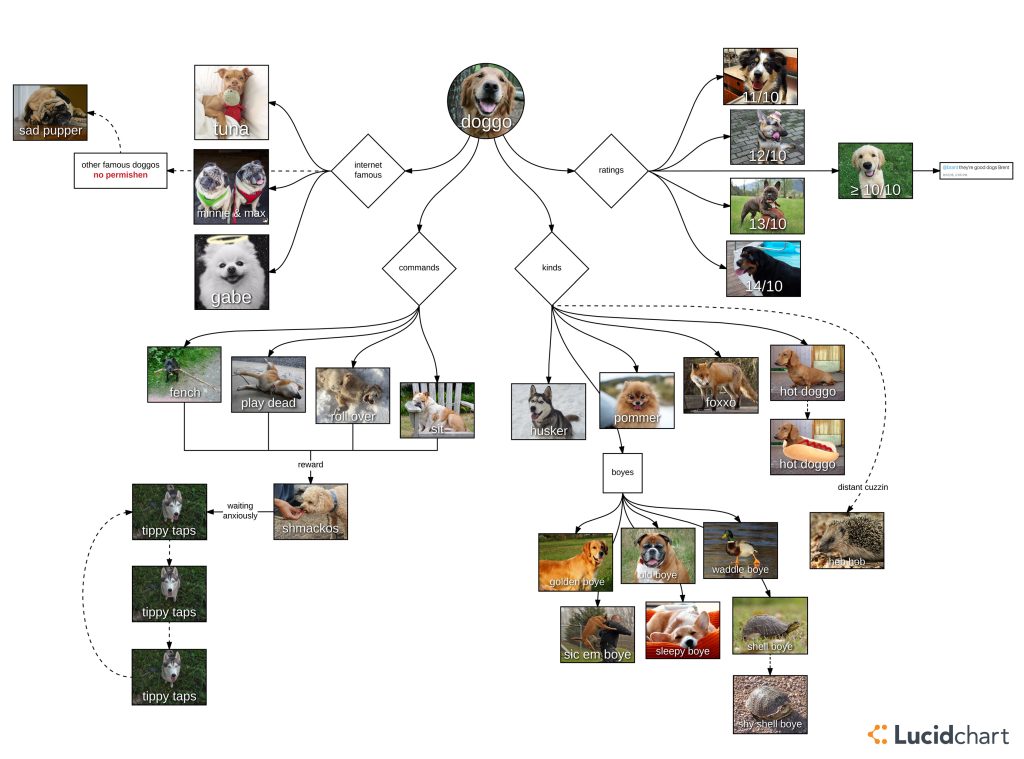
You can try imagining mindmaps, but they are generally easier to recall if you draw them and remember them. The visuals and “location data” make all the difference.
Note to you
What you remember with which technique is totally up to your creativity. I strongly encourage trying these out daily to figure out what you need to remember and what’s the best way.
| Technique name | Feature | Use case |
|---|---|---|
| Chunking | Compacts information | All types of information |
| Major System | Converts numbers to words | Long or unpatterned numbers like numerical constants |
| Mind Palace | Stores information on a mental blueprint of a location | Ordered information, descriptive study material |
| Number-visualization Peg System | Recalling any item in an ordered list without going through the list | Random everyday items, ordered lists |
| Acronyms | Compacts information | Concepts, Business strategies, methods, and how-tos |
| Acrostics | Increases ease of recall | Grammar rules, Lyrics, Speeches, Definitions |
| Musical Rhythm | Increases ease of recall | Grammar rules, Lyrics, Speeches, Definitions |
| Storification (linking) | Connects items one by one in a story form | Temporary list of everyday items |
| Keyword method | Anchors new words to old words | New vocabulary, concept words |
| Mind mapping | Organizes information | Large structures of data, concepts and categories, study material |
You have a real chance to be a memory champion with these techniques; the champions use them, and so can you!
If you want to just improve your raw memorizing capacity, I recommend reading this article.
Sources
[2]: https://nyaspubs.onlinelibrary.wiley.com/doi/abs/10.1196/annals.1360.017
[3]: https://www.lucidchart.com/blog/doggo-diagram-3-meme

Hey! Thank you for reading; hope you enjoyed the article. I run Cognition Today to capture some of the most fascinating mechanisms that guide our lives. My content here is referenced and featured in NY Times, Forbes, CNET, and Entrepreneur, and many other books & research papers.
I’m am a psychology SME consultant in EdTech with a focus on AI cognition and Behavioral Engineering. I’m affiliated to myelin, an EdTech company in India as well.
I’ve studied at NIMHANS Bangalore (positive psychology), Savitribai Phule Pune University (clinical psychology), Fergusson College (BA psych), and affiliated with IIM Ahmedabad (marketing psychology). I’m currently studying Korean at Seoul National University.
I’m based in Pune, India but living in Seoul, S. Korea. Love Sci-fi, horror media; Love rock, metal, synthwave, and K-pop music; can’t whistle; can play 2 guitars at a time.




























I keep trying to buy a coffee but it keeps rejecting my American credentials.
Hey Annette, I really appreciate that 😀 Ooops, thanks for bring up the problem. Can you please tell me what error message you get and what payment methods you’ve tried? I’m troubleshooting on the side 🙂